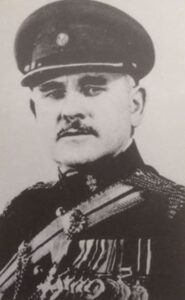Major Patrick Cleere, who has died aged 81, fought in the 7th Hussars in all the major battles and some minor ones from 1940 to 1945, including North Africa, Italy and Burma.

He was described by his CO as “an outstanding leader, quick to grasp the situation and always cool-headed and fearless”.
Patrick Cleere was born at Tarrigeen, Kilkenny, on January 11, 1917. Up to the age of 12, he attended, intermittently, the local school at Knocktopher, in between working on local farms.
Although he was apprenticed as a stonemason he gave it up and enlisted in the 7th Hussars in 1933. He was a year underage, but nobody realised this. Having gained experience in “rough-riding” and the training of polo ponies he was posted to Egypt in 1935.
In January 1941 he was awarded the Distinguished Conduct Medal in the attack on Tobruk when his troop leader’s tank was blown up on a mine as they were attacking three gun emplacements.
Cleere closed up on the damaged tank, attached a tow rope, which several times had to be reconnected under fire, and towed it back for 1,000 yards. when soft ground made further progress impossible, and both tanks had been hit by enemy fire, he then put both crews, some of whom were wounded, inside his own tank.
As there was now no room for him inside, he sat on the outside and directed the driver which way to go. General Wavell, then Commander-in-Chief, Middle East, was so impressed by Cleere’s coolness and courage that he wrote him a special note.
His tank was soon repaired and back in action, even though it still had a hole in it made by a Breda shell. In February 1941 he rounded up 300 Italian prisoners near Benghazi. At the end of the next round of fighting his tank became so battered it became an exhibit.
For subsequent battles, he received “Cruiser” tanks and American “Honeys”. With these, he was sent to Burma where he took part in the rearguard action against the Japanese.
In March 1942 he was involved in the battle of the Prome Roadblock, where the bridge was blocked with the burning vehicles. Told he had to get through at all costs, he drove through the jungle until he found a place where the river was shallow enough to allow crossing: many followed.
At Kyaukse (another bridge) he was strafed by four Japanese fighter bombers. Under continuous fire, he rescued the crew of a damaged tank, all of whom were wounded. He was several times knocked off his feet by bomb blasts. He was recommended for a Bar to his DCM, but the documents were lost in the general retreat.
After being re-equipped in India and trained on Grant tanks he was sent in turn to Basra, Baghdad, Jordon, Palestine and Syria. In 1943 his unit was sent to Lebanon, then to Egypt and Italy.
In Italy, his regiment came under the command of the 2nd Polish Corps. Cleere’s troop took part in the capture of the villages along the Croce di San Vincenzo ridge. In September 1944 they were involved in the battles around Croce and took many German prisoners.
Later, when helping the Padre to retrieve and bury bodies, he came across the body of his own brother, who had been serving in a different squadron of the same regiment.
At the end of 1944, he returned to England and began training on Cromwell tanks, but the war ended before he could go into action again.
From 1947 to 1954, he was seconded to the Leicestershire Yeomanry, before returning to the 7th Hussars, with whom he spent three years in Hong Kong.
In 1958, when the 7th and 3rd Hussars were amalgamated to form The Queen’s Own Hussars, Cleere became the regiment’s first RSM. However, almost immediately afterwards he was commissioned.
After a period on detachment with the Staffordshire Yeomanry, he returned to the QOH as Technical Quartermaster in 1962. He served in Germany and then in 1967 accompanied the regiment to Aden. He spent his last two years in the Army, from 1967 to 1969, as Quartermaster of the Junior Leaders Royal Armoured Corps.
He was awarded the MBE in 1969.
Endowed with a commanding presence, towering figure and enormous voice, Paddy Cleere ensured respect from the start. He was invariably cheerful and resourceful.


